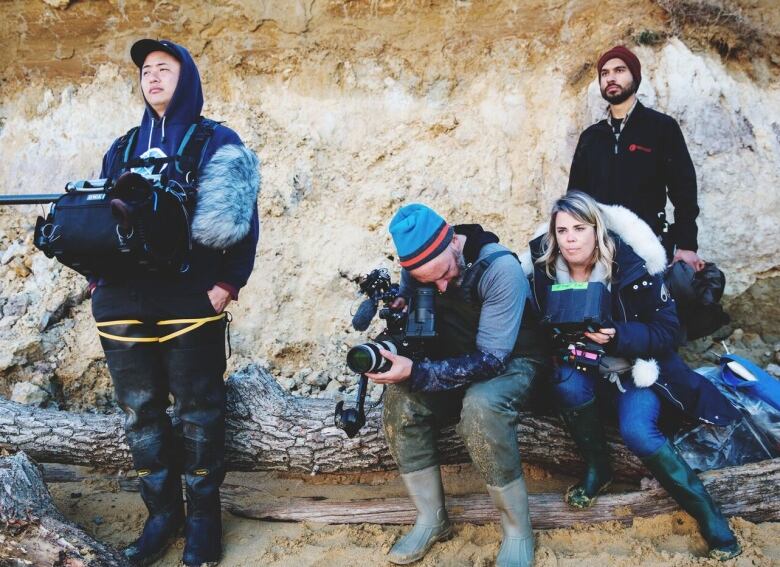Director defends documentary that claims Europeans could have been 1st humans in North America

The director of a documentary set to air on CBC's The Nature of Things is defending her work amid widespread criticism from scientists and Indigenous people.
Ice Bridge explores the Solutrean hypothesis — the idea that people from Europe may have been the earliest settlers of the Americas. Narrated by David Suzuki, it's set to air on CBC on Sunday.
The hypothesis suggests the Solutreans, an ancient people from Spain and France, migrated across the sea ice 20,000, years ago, bringing with them advanced tool-making technology.
The hypothesis has been used in white supremacist propaganda and is rejected by the mainstream, but Ice Bridge director Robin Bicknell told As It Happens host Carol Off it's still worth exploring.
Here is part of their conversation.
There are many, many anthropologists and paleo-anthropologists who completely discredit this idea. As you approached it, what state of mind were you in about this?
I had to have an open mind, and I think that I was quite impressed with the scientists themselves, who seemed very measured.
This is Bruce Bradley and Dennis Stanford?
These are two very, very skilled archeologists at the top of their game. For me, I just heard them out.
What does [the film] actually show you is the evidence to actually support the Solutrean hypothesis?
We gained exclusive access to a dig — an archeological excavation that was happening in the Chesapeake Bay that was producing artifacts that have extremely close alignment to Solutrean tools. And this, in a way, was fresh, new evidence for a hypothesis that they've been putting forward for about 20 years.
The biggest thing that made them both sort of scratch their head and think maybe there's something to this are the tools themselves. And it's the way that they're fashioned. It's the way that they're made. It's called flint-knapping — when you knock one rock into a piece of flint and they flake off in various forms.
The Solutreans did it in a particularly unique way that no one else did, except for some of these artifacts that Bruce and Dennis have found in North America in the East Coast.

Is it not possible that two peoples at different times discovered that technique and started making it?
It's not just one tool. It's an assemblage of tools. The odds of that being replicated independently in two parts of the world ... in their view, is almost none.
The other scientists you have in the documentary, they don't just question this a bit. They completely dismiss this.
Some people were critical from a knowledgeable place, but many, many were critical from a place of not really understanding it or ever having given it the time of day.
This Solutrean theory is supported and purported by white supremacists who argue ... this proves that early Europeans were in early North America, and that those that came later to "discover" North America were simply reclaiming what had belonged to white Europeans. North America belongs to Europe and these other people, Indigenous people, were interlopers they were fighting. Were you not playing into those hands when you made this documentary?
In no way was this part of the film, and it's not really part of the hypothesis.

Why didn't you have that part of the film, that there were these controversial aspects of it?
If white supremacists want to view this theory through their lens and place on their version of history on people of the past, then there's nothing I can do about it. But it is a ludicrous notion. It has no place in healthy, intelligent scientific debate.
So 20,000 years ago, there's probably several hundred thousand people on planet Earth. And those people in no way resemble modern Europeans whatsoever. If a white supremacist has a vision of Hitler Youth in boats bravely crossing the Atlantic, nothing could be farther from the truth and I just didn't want to give a lick of credence to a ludicrous notion.

What about Indigenous people who question this theory and feel that it's hurtful?
In conjunction with the Huron-Wendat, we made this film. There's an Indigenous group that is inclusive in this story because their origin story puts their ancestors having arrived from the east over a great salted lake. So the Huron-Wendat were willing to do something, which is relatively unheard of, which is to willingly provide ancient human remains to look at the genetics of their ancestors, which you can do when you look at the DNA.
What do you want people to take away from watching your documentary?
We should question theories even if they have been put forward for thousands of years. Alfred Wegener had a hard time convincing people that there were tectonic plates. It took 50 years for anyone to think, for it to be accepted. People thought he was crazy too.
Do you think people will eventually accept the Solutrean theory as fact?
Whether Bradley and Stanford are right is not the point. The point is it is worthy of looking at.
This transcript has been edited for length and clarity. For more, listen to Carol Off's full conversation with Robin Bicknell in the player above.